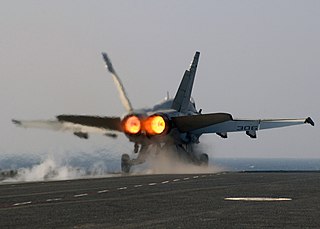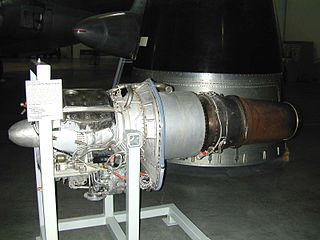Related Research Articles

Pratt & Whitney is an American aerospace manufacturer with global service operations. It is a subsidiary of Raytheon Technologies. Pratt & Whitney's aircraft engines are widely used in both civil aviation and military aviation. Its headquarters are in East Hartford, Connecticut. As one of the "big three" aero-engine manufacturers, it competes with General Electric and Rolls-Royce, although it has also formed joint ventures with both of these companies. In addition to aircraft engines, Pratt & Whitney manufactures gas turbines for industrial and power generation, and marine turbines. In 2017, the company reported that in 2014 they had 38,737 employees supporting more than 11,000 customers in 180 countries around the world. In 2013, Pratt & Whitney's revenue totaled $14.5 billion. The company remained in the umbrella of its parent company after the merger of United Technologies and Raytheon.

The turbofan or fanjet is a type of airbreathing jet engine that is widely used in aircraft propulsion. The word "turbofan" is a portmanteau of "turbine" and "fan": the turbo portion refers to a gas turbine engine which achieves mechanical energy from combustion, and the fan, a ducted fan that uses the mechanical energy from the gas turbine to accelerate air rearwards. Thus, whereas all the air taken in by a turbojet passes through the turbine, in a turbofan some of that air bypasses the turbine. A turbofan thus can be thought of as a turbojet being used to drive a ducted fan, with both of these contributing to the thrust.

An afterburner is an additional combustion component used on some jet engines, mostly those on military supersonic aircraft. Its purpose is to increase thrust, usually for supersonic flight, takeoff, and combat. Afterburning injects additional fuel into a combustor in the jet pipe behind the turbine, "reheating" the exhaust gas. Afterburning significantly increases thrust as an alternative to using a bigger engine with its attendant weight penalty, but at the cost of very high fuel consumption which limits its use to short periods. This aircraft application of reheat contrasts with the meaning and implementation of reheat applicable to gas turbines driving electrical generators and which reduces fuel consumption.

The Pratt & Whitney Canada PT6 is a turboprop aircraft engine produced by Pratt & Whitney Canada. Its design was started in 1958, it first ran in February 1960, first flew on 30 May 1961, entered service in 1964 and has been continuously updated since. It consists of two basic sections: a gas generator with accessory gearbox and a free power turbine with reduction gearbox, and is often seemingly mounted backwards in an aircraft in so far as the intake is at the rear and the exhaust at the front. Many variants of the PT6 have been produced, not only as turboprops but also for helicopters, land vehicles, hovercraft, boats, as auxiliary power units and for industrial uses. By November 2015, 51,000 had been produced, had logged 400 million flight hours from 1963 to 2016. It is known for its reliability with an in-flight shutdown rate of 1 per 651,126 hours in 2016. The PT6A covers the power range between 580 and 1,940 shp while the PT6B/C are turboshaft variants for helicopters.

The Rolls-Royce RB.44 Tay was a British turbojet engine of the 1940s, an enlarged version of the Rolls-Royce Nene designed at the request of Pratt & Whitney. It saw no use by British production aircraft but the design was licence built by Pratt & Whitney as the J48, and by Hispano-Suiza as the Verdon.

The LHTEC T800 is a turboshaft engine for rotary wing applications. It is produced by the LHTEC, a joint venture between Rolls-Royce and Honeywell. The commercial and export version is the CTS800. The engine was primarily developed for the United States Army's cancelled RAH-66 Comanche armed reconnaissance helicopter, but has found use in other applications.
GE Aviation, a subsidiary of General Electric, is headquartered in Evendale, Ohio, outside Cincinnati. GE Aviation is among the top aircraft engine suppliers, and offers engines for the majority of commercial aircraft. GE Aviation is part of the General Electric conglomerate, which is one of the world's largest corporations. The division operated under the name of General Electric Aircraft Engines (GEAE) until September 2005. GE Aviation's main competitors in the engine market are Rolls-Royce and Pratt & Whitney. GE operates two joint ventures with Safran Aircraft Engines of France, CFM International and CFM Materials.

The Pratt & Whitney F135 is an afterburning turbofan developed for the Lockheed Martin F-35 Lightning II, a single-engine strike fighter. It has two variants; a Conventional Take-Off and Landing (CTOL) variant used in the F-35A and F-35C, and a two-cycle Short Take-Off Vertical Landing (STOVL) variant used in the F-35B that includes a forward lift fan. The first production engines were delivered in 2009.

The Pratt & Whitney J58 was an American jet engine that powered the Lockheed A-12, and subsequently the YF-12 and the SR-71 aircraft. It was an afterburning turbojet with a unique compressor bleed to the afterburner which gave increased thrust at high speeds. Because of the wide speed range of the aircraft the engine needed two modes of operation to take it from stationary on the ground to 2,000 mph (3,200 km/h) at altitude. It was a conventional afterburning turbojet for take-off and acceleration to Mach 2 and then used permanent compressor bleed to the afterburner above Mach 2. The way the engine worked at cruise led it to be described as "acting like a turboramjet". It has also been described as a turboramjet based on incorrect statements describing the turbomachinery as being completely bypassed.
Pratt & Whitney Canada is a Canada-based aircraft engine manufacturer. PWC's headquarters are in Longueuil, Quebec, just outside Montreal. It is a division of the larger US-based Pratt & Whitney (P&W), itself a business unit of Raytheon Technologies Corporation. United Technologies has given PWC a world mandate for small and medium aircraft engines while P&W's US operations develop and manufacture larger engines.

The Pratt & Whitney J57 is an axial-flow turbojet engine developed by Pratt & Whitney in the early 1950s. The J57 was the first 10,000 lbf (45 kN) thrust class engine in the United States. The J57/JT3C was developed into the J75/JT4A turbojet, JT3D/TF33 turbofan, and PT5/T57 turboprop. The J57 and JT3C saw extensive use on fighter jets, jetliners, and bombers for many decades.

The Pratt & Whitney JT12, is a small turbojet engine. The Pratt & Whitney T73 is a related turboshaft engine.

The Pratt & Whitney T73 is a turboshaft engine. Based on the JT12A, the T73 powered the Sikorsky CH-54 Tarhe and its civil counterpart Sikorsky S-64 Skycrane flying crane heavy-lift helicopters. Turboshaft versions for naval use are known as the FT12.

The Pratt & Whitney Canada PT6T Twin-Pac is a turboshaft engine designed for helicopters. Manufactured by Pratt & Whitney Canada, its first application was in the Bell 212 and UH-1N Twin Huey helicopter family. The PT6T Twin-Pac consists of two PT6A power turbines driving a common output reduction gearbox, producing up to 2,000 hp at 6,000 rpm. The engine is designated T400 by the U.S. military.

The Pratt & Whitney/Allison 578-DX was an experimental aircraft engine, a hybrid between a turbofan and a turboprop known as a propfan. The engine was designed in the 1980s to power proposed propfan aircraft such as the Boeing 7J7 and the MD-91 and MD-92 derivatives of the McDonnell Douglas MD-80. As of 2019, it is still one of only four different contra-rotating propfan engines to have flown in service or in flight testing.
The Pratt & Whitney GG4 and FT4 are related aero-derivative gas turbine engines developed from the Pratt & Whitney J75/JT4 turbojet line. They are axial twin spool turbojets with a can-annular type combustion element, typically operated as turboshaft engines. In this configuration the gas generator provides the expanding gases to drive a power or “Free Turbine”. This turbine is then used to drive electrical generators, mechanical pumps or propellers for marine applications.
The Avco/Pratt & Whitney T800 was a turboshaft engine for rotary wing applications, and was produced by Avco/Pratt & Whitney (APW), a joint venture between Avco Lycoming and Pratt & Whitney. The engine was developed for the United States Army's LHX armed reconnaissance helicopter competition to develop the Boeing-Sikorsky RAH-66 Comanche, but lost to the competing LHTEC T800 in 1988.

The Improved Turbine Engine Program (ITEP), formerly the Advanced Affordable Turbine Engine (AATE) program, is a United States Army project to develop a General Electric T700 replacement for the UH-60 Black Hawk and AH-64 Apache, improving fuel consumption, power, durability and cost. Honeywell and Pratt & Whitney formed the ATEC joint venture to develop the T900, while GE Aviation builds the T901. The US Army selected the GE T901 as the winner of the program in February 2019.

The Hiller Ten99 was an American 1961 experimental helicopter, created by Hiller Aircraft.

The Pratt & Whitney XT57 was an axial-flow turboprop engine developed by Pratt & Whitney in the mid-1950s. The XT57 was developed from the Pratt & Whitney J57 turbojet.
References
- Notes
- Bibliography
- Connors, Jack (2010). The Engines of Pratt & Whitney: A Technical History. Reston. Virginia: American Institute of Aeronautics and Astronautics. ISBN 978-1-60086-711-8.